The Intricacies of Kiteboarding: Art and Community
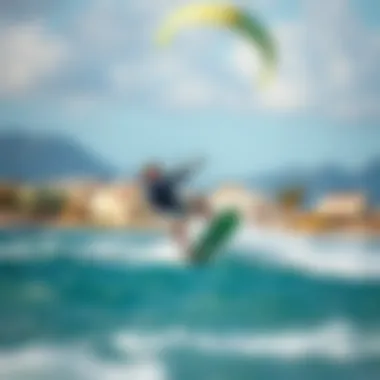
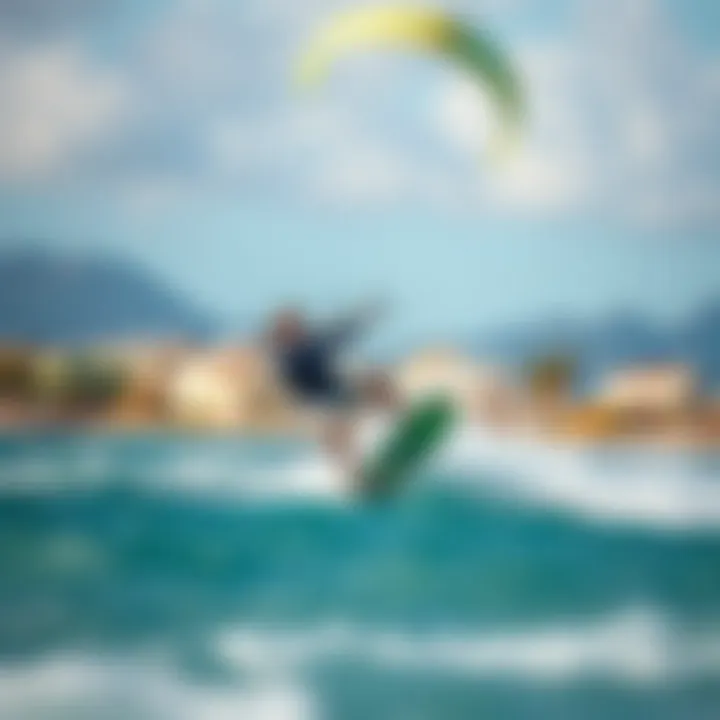
Intro
Kiteboarding, at its core, combines the thrilling elements of surfing, wakeboarding, and flying a kite. This sport offers a unique blend of technical skill and artistic expression, giving practitioners a chance to harness the power of the wind. The allure lies not just in the high-speed rides or acrobatics on the water, but also in the community that thrives around it. From seasoned riders to curious newcomers, each participant brings a bit of their own flair to the mix.
With the right know-how, you can navigate the nuances of this exhilarating sport. Let’s dive into the intricacies of kiteboarding, from understanding the essential equipment to mastering various techniques, ensuring that every kiteboarder, whether a novice or a pro, can find insight and inspiration.
Equipment Insights
Kiteboarding equipment is more than just tools; it's an extension of the rider's personality, allowing for individual expression while engaging with the elements of nature. This section explores the latest gear trends and maintenance essentials.
Latest Gear Reviews
The kiteboarding market is ever-evolving, with new innovations popping up regularly. Riders can choose from an array of kites, boards, harnesses, and accessories that cater to different skill levels and preferences.
- Kites: Current offerings range from leading brands like North Kiteboarding and Slingshot. For instance, the North Reach kite focuses on versatility, offering excellent upwind performance. The Slingshot RPM, on the other hand, is renowned for its stability and responsiveness, making it a favorite among both beginners and advanced riders.
- Boards: The type of board you choose impacts your performance on the water. The Liquid Force Envoy is a solid choice for beginners, featuring a lightweight construction that makes it easy to learn. Meanwhile, experienced riders might lean towards the Naish Slash for its aggressive design and ability to handle powerful winds.
- Harnesses and Accessories: Comfortable harnesses, like the ION Riot, provide essential support while allowing for movement. Safety gear, such as impact vests, is also critical—consider products like the Mystic Marshall for ample protection without sacrificing comfort.
Essential Gear Maintenance
Taking care of your kiteboarding equipment ensures longevity and performance. Here are some tips for keeping your gear in top shape:
- Kite Care: After every session, rinse your kite with fresh water to remove salt and debris. Store it in a cool, dry place, away from direct sunlight.
- Board Maintenance: Regularly check your board for dings or scratches. Waxing periodically not only improves performance but also enhances durability.
- Harness Upkeep: Inspect your harness straps and buckles for wear. Reinforce any weak points to avoid surprises on the water.
"Regular maintenance can extend the life of your equipment and provide the performance edge you need on the water."
Technique Exploration
The beauty of kiteboarding doesn’t simply rest in the gear; rather, it’s about how you wield it. Execution of techniques makes a rider stand out, whether learning the ropes or perfecting advanced moves.
Beginner Techniques
For those just starting their kiteboarding journey, grasping the basics is crucial. The following steps can help beige flyers transition to confident riders:
- Understanding the Wind Window: Knowing how to position your kite relative to the wind is vital. Practice flying the kite on land before hitting the water.
- Learning to Water Start: Position yourself in the water with one hand on the control bar and the other ready with your board positioned. Once you find the right wind, the kite will lift you.
- Basic Turns: Once you’re up, practice turning by shifting your weight. This will give you a feel of control and enhance your confidence.
Advanced Maneuvers
Once you feel stable on the board, you might want to impress your friends with some stylish moves:
- Jumping: Learning to jump requires precision. Ensure you have enough speed and pop into your jump by pulling the bar while pushing down on your heels.
- Board Off Tricks: For the more adventurous, this trick involves releasing your board mid-air while maintaining control of the kite. It's all about balance and timing.
- Kiteloops: This dynamic maneuver combines a jump and a rotation with the kite, but it demands an experienced handle over kite control. Make sure conditions are favorable, and your skills are locked down before attempting.
For a deeper dive into kiteboarding culture and additional resources, check out Wikipedia or join discussions on platforms like Reddit or Facebook.
Stay tuned for more insights on kiteboarding in later sections!
Intro to Kiteboarding
Kiteboarding stands at the crossroads of adrenaline and artistry. This captivating sport invites individuals to harness the wind’s energy and navigate across the water with a blend of skill, balance, and finesse. The unique appeal of kiteboarding lies not just in its physical demands but also in its ability to foster a sense of freedom and connection with nature. For enthusiasts, it's about more than just the thrill; it’s a lifestyle that intertwines community, culture, and personal expression.
Defining Kiteboarding
At its core, kiteboarding is a water sport where riders use a large controllable kite to pull themselves across the water on a board. Just picture it: you're gliding over waves, the sun is kissing your skin, and with every move, you feel like you're flying. The kites, ranging from sizes depending on the wind conditions, are designed to catch the breeze efficiently. The rider controls the kite using handles or a bar connected to lines, which adds a layer of skill to the experience.
The sport's beauty lies in its diversity. Kiteboarding encompasses various styles, including freestyle and wave riding. Each style presents its own techniques and challenges. For instance, freestyle focuses on aerial tricks, whereas wave riding involves navigating ocean swells. This wide range makes kiteboarding appealing to a broad audience, from beginners trying to catch their first gust of wind to seasoned pros pushing their limits during competitions.
The Evolution of the Sport
Kiteboarding didn’t just appear out of thin air. It has a rich evolutionary history which helps to explain its current form. The sport can trace its roots back to the late 1970s when pioneering inventors began experimenting with wind-powered devices. By the 1990s, modern kiteboarding emerged thanks to technological advances in kite design, materials, and safety mechanisms.
The 2000s saw an explosion of interest, driven by the introduction of better equipment and safety standards. This was the decade when brave souls started putting on shows at beaches worldwide, showcasing tricks and styles that were previously unimaginable. Over the years, kiteboarding has become an international phenomenon, with events and competitions held globally.
"Kiteboarding is not just a sport; it's a movement that transforms lives."
Kiteboarders formed tight-knit communities, turning local spots into epicenters of culture and camaraderie. Alongside the evolution of the sport, technology has made significant strides, providing a host of gadgets like GPS trackers and smartwatches, which allow riders to chart their progress and improve their skills.
In summary, understanding kiteboarding requires recognizing both its definition and its evolution. As it continues to grow, the sport remains a harmonious blend of excitement, innovation, and community that captivates many across the globe.
Understanding the Mechanics of Kiteboarding
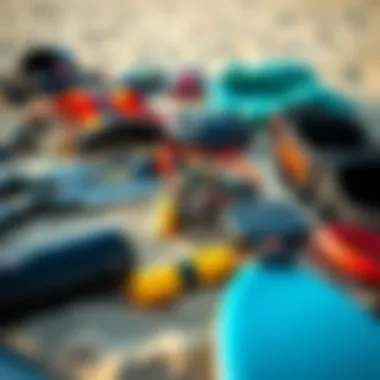
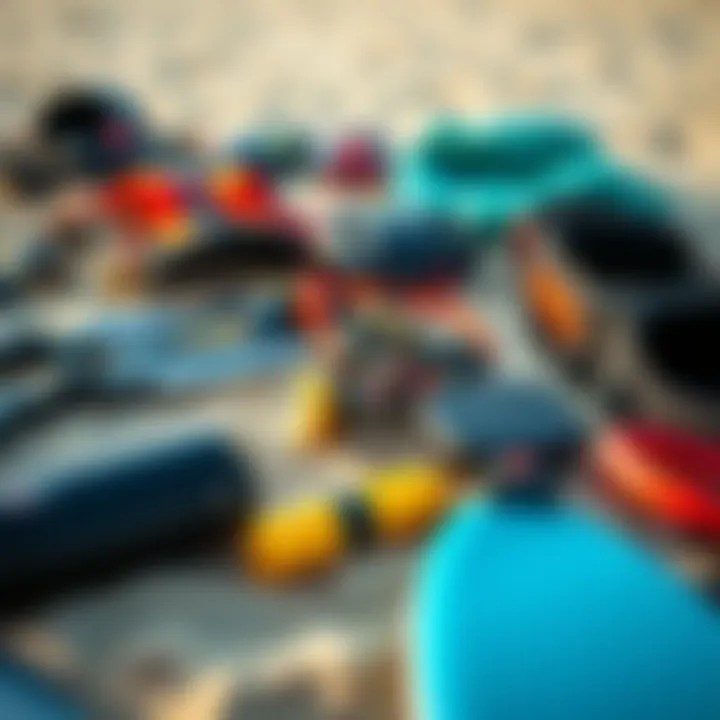
Kiteboarding stands out as a sport that harmonizes the rider's skill with nature's whims. Understanding the mechanics behind kiteboarding isn’t just about mastering techniques; it's about developing a connection with the wind, the water, and the equipment. For enthusiasts and instructors alike, delving into this topic offers insights that can elevate performance and safety while navigating the waves.
Kite Design and Functionality
Kite design plays a pivotal role in determining the performance and experience of kiteboarding. Various types of kites—such as inflatable kites, foil kites, and hybrid designs—serve different purposes, each tailored to specific wind conditions and rider preferences. For instance, inflatable kites with their robust structure are ideal for beginners or for use in gusty winds. That said, foil kites, which consist of cells that fill with air, can offer enhanced performance in lighter wind conditions.
- Shape: The shape of the kite influences lift and drag. C-shaped kites tend to excel in speed and jumping capabilities, while delta-shaped kites offer more stability and easier handling.
- Material: Often made from ripstop nylon or similar materials, the kite’s fabric affects durability and weight. High-quality materials can resist wear and tear, enabling longer rides and reducing the need for frequent replacements.
- Size: The size of the kite directly impacts how it interacts with wind speed. Smaller kites are quicker and provide increased control in high winds, while larger kites generate more lift in light winds.
Understanding these factors can help riders select the right kite for their skill level and riding style, enhancing enjoyment and safety on the water.
Harnesses: An Essential Element
To connect the kite to the rider, harnesses are fundamental. Many may think of harnesses as mere attachments, but they actually serve as the bridge between the rider's body and the kite. There are various types of harnesses—seat harnesses, waist harnesses, and even hybrid options. Each has its benefits and pitfalls.
- Seat Harnesses: These are lower on the body, providing support around the hips and thighs. They distribute pressure evenly, making them comfortable for extended sessions, especially for novices who may require added stability.
- Waist Harnesses: These sit higher on the torso, allowing for greater mobility and range of motion. They're often preferred by more experienced riders who perform tricks requiring flexibility in movement.
- Hybrid Harnesses: These bring together the best of both worlds, catering to various styles and preferences.
When selecting a harness, riders should consider personal comfort, fit, and the type of riding they plan to pursue. A good harness should fit snugly without constriction, allowing for maximum control as one maneuvers through the water.
Boards: Styles and Types
The board is the vehicle through which a rider navigates the currents. Choosing the right one can significantly impact performance and ease of riding. Boards come in various styles, each serving distinct purposes depending on rider skill and the prevailing conditions.
- Directional Boards: Resembling a surfboard, these are designed primarily for riding in one direction, similar to surfing. They excel in waves and are often favored by those who enjoy kitesurfing.
- Twin Tip Boards: These boards are symmetrical, allowing for riding in both directions. They are ideal for new kiteboarders and those looking to perform tricks or jumps.
- Freestyle and Freeride Boards: These boards are specially designed for specific tricks or comfortable rides, accommodating the preferences of the rider.
Considering factors like size, weight, and shape can greatly enhance the riding experience. Having the right board helps improve performance, ensuring every session feels like a breeze, whether a novice or a seasoned pro.
Understanding the mechanics of kiteboarding is akin to knowing the pulse of the sport. From the intricacies of kite design to the suitability of chosen boards and harnesses, every element plays its part in shaping a kiteboarder's experience on the water. The more involved you become with these basics, the better equipped you will be to handle whatever the breeze may throw your way.
"A kiteboarder’s connection with their equipment is as vital as their ability to read the wind. Without that synergy, every ride is just another dip in the water."
For further exploration of kiteboarding mechanics and community experiences, you may visit Wikipedia's Kiteboarding page and Reddit's Kiteboarding community.
The Role of Wind in Kiteboarding
Kiteboarding is intrinsically tied to the presence and behavior of wind. Without wind, kiteboarding would not only be challenging; it would be nearly impossible. The importance of wind in this sport extends beyond just powering the kite; it shapes the entire experience, affecting everything from performance to safety. Understanding wind dynamics is critical for anyone looking to master this exhilarating sport.
Understanding Wind Patterns
Wind patterns dictate the conditions under which kiteboarders operate. They aren’t just random gusts; they come in various forms, influenced by geographical features and weather systems. The following factors influence wind patterns crucial for kiteboarding:
- Local Geography: Coastal areas, mountains, and bodies of water all contribute to unique wind patterns. For instance, wind funneling can occur in narrow channels, leading to sudden gusts.
- Thermal Winds: These occur due to heat differences between land and water. On sunny days, land heats up quicker than surrounding water, causing winds to flow from sea to land. This thermal effect is vital, especially for kiteboarding during hot afternoons.
- Directional Winds: Some kiteboarding spots have reliable winds blowing in a particular direction at specific times of the day. Knowledge of these can significantly enhance performance.
Understanding these patterns enables kiteboarders to choose appropriate locations and times for their sessions. Wind conditions often dictate the choice of equipment, such as kite size and type.
"Wind is not just a factor; it’s the life force of kiteboarding—understanding it is not optional; it’s essential."
Weather Conditions and Kiteboarding
Weather conditions play a significant role in the kiteboarding experience. For one, kiteboarding cannot be separated from its environmental context. Key considerations include:
- Wind Speed: Ideal wind speeds for beginners generally range from 10 to 20 knots, while experienced riders might chase winds up to 30 knots or more. Going beyond this range can pose substantial risks.
- Storms and Squalls: Sudden storms can lead to dangerous conditions for kiteboarders. Recognizing storm clouds and changes in wind direction is vital for safety.
- Temperature and Humidity: Hot and humid conditions can affect the rider's stamina and focus. Understanding local climate can help kiteboarders plan adequately, ensuring they are physically prepared for their sessions.
To summarize, the success and safety of kiteboarding are deeply influenced by the wind and weather. For those considering diving into kiteboarding, take the time to truly understand these elements. The wind is not just a friend; it’s a partner in the art of kiteboarding.
Kiteboarding Techniques for All Levels
Kiteboarding, a thrilling blend of surfing, paragliding, and windsurfing, requires a solid understanding of techniques tailored to different skill levels. This diversity in skill sets not only enhances the individual's experience but also fosters a safer and more enjoyable environment on the water. As the kiteboarder progresses from a novice to an expert, having these foundational and advanced techniques at their fingertips can significantly impact their confidence and overall performance.
Beginner Essentials
Getting started with kiteboarding can feel a bit overwhelming, but by mastering the beginner essentials, anyone can turn initial apprehension into exhilaration. The first step is often learning how to fly the kite on land before taking it to the water. This practice allows beginners to develop a feel for the wind and the kite's responsiveness.
Key Techniques for Beginners:
- Kite Control: Learning how to steer the kite effectively is crucial. Beginners should practice flying a trainer kite to grasp how the input on the control lines translates to movement.
- Body Dragging: Once comfortable with kite control, the next step is body dragging in the water. This technique teaches how to be pulled by the kite while staying afloat and is fundamental before progressing to riding the board.
- Water Relaunch: It's inevitable that beginners will drop the kite. Learning how to relaunch it from the water is vital for getting back in action quickly.
The essential techniques form a solid foundation for safe kiteboarding. By focusing on these skills, new kiteboarders build confidence while minimizing risks associated with kiteboarding.
Intermediate Skills
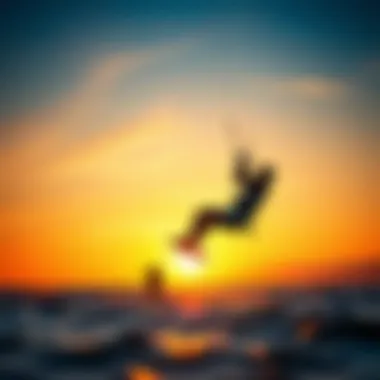
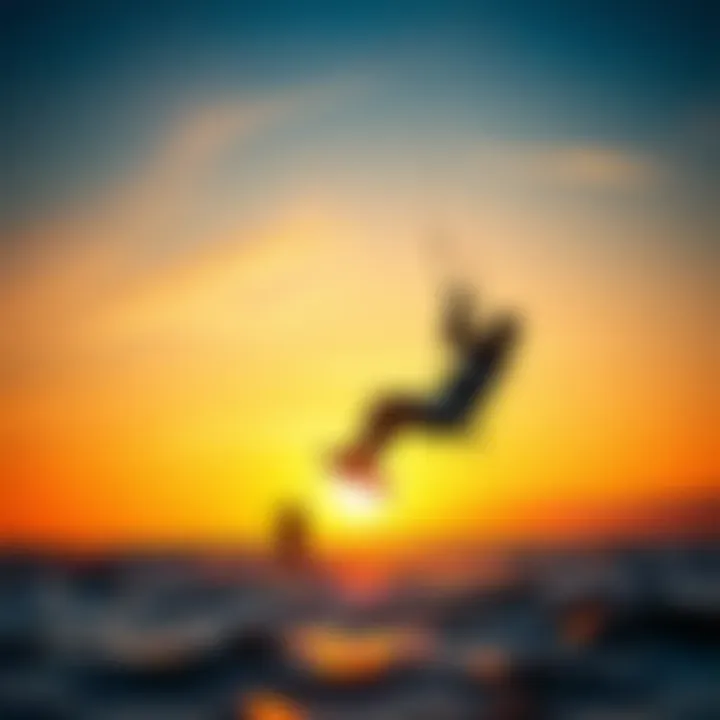
As kiteboarders transition from novice to intermediate levels, their focus shifts toward enhancing finesse and diversity in their maneuvers. Intermediate skills often center around refining control and introducing new tricks. It’s about making that kite dance while you cut through the waves.
Intermediate Techniques to Master:
- Riding Upwind: Learning to ride upwind allows the kiteboarder to cover more distance. Riders practice edging the board against the pull of the kite, which demands good balance and technique.
- Jumping: This entails making use of the kite’s lift to jump higher. Properly timing the pull of the kite and the rider's take-off is crucial for both performance and safety.
- Transitions: Mastering transitions from heel-side to toe-side (and vice versa) enhances fluidity on the water. This skill is essential for more advanced moves.
Intermediate techniques elevate the riding experience, offering increased agility and control. With these skills, riders can expand their repertoire and take on more challenging conditions with ease.
Advanced Maneuvers
For those who have honed their skills and seek the thrill of advanced maneuvers, it's all about pushing boundaries. Advanced kiteboarders often share a common drive: the desire to combine technical skill with creativity. At this level, performance can be enhanced through various tricks, spins, and flips.
Advanced Techniques to Explore:
- Handle Passes: This trick involves passing the bar behind your back while in mid-air, showcasing both skill and style.
- Kite Looping: By pulling hard on the front line during a jump, kiteboarders can create a loop that can increase airtime and thrill. Precision here is key; timing and kite control are critical to execute it safely.
- Unhooked Tricks: Riding without the safety of the harness changes the game entirely. This requires refined skills in balance and kite control, making each trick far more demanding.
Engaging in these advanced maneuvers not only enhances an individual’s skill set but also opens up new avenues for creativity, allowing kiteboarders to express their artistry on the water.
"Kiteboarding is not just about flying a kite; it’s about embracing the wind and dancing with the waves.”
For more information on kiteboarding, check out resources like Wikipedia, Britannica, and community pages on Reddit.
Jumping on the kiteboarding bandwagon could very well lead one to discover some of the most exhilarating moments life has to offer.
Safety Considerations in Kiteboarding
When stepping onto the water with a kite in tow, safety should always take the forefront. Kiteboarding, while exhilarating, carries its share of risks and hazards. A deep comprehension of these elements is vital in protecting oneself and ensuring that the experience remains enjoyable and memorable. This section examines the various risks associated with kiteboarding, along with recommendations on essential protective gear that could make all the difference in maintaining a safe environment while enjoying the sport.
Understanding Risks
Kiteboarding often highlights the delicate balance between thrill and caution. To fully enjoy this sport, it's crucial to be aware of potential dangers—some that might seem apparent, while others are quite subtle.
One primary risk involves the unpredictable nature of wind. Sudden gusts can catch even the most seasoned kiteboarders off guard. As a result, it’s essential to pay attention to the local weather forecasts and understand how conditions can change, even within a short period. A kiteboarder should always assess wind strength and direction before setting sail.
Some common risks include:
- Kite Tangle: Lines can sometimes become tangled, leading to unforeseen complications in maneuverability.
- Equipment Failure: Gear can fail, whether through wear and tear or manufacturing defects. Regular equipment checks can mitigate this risk.
- Collisions: Whether with other kiteboarders, swimmers, or obstacles, collisions can cause serious injuries.
"Safety isn’t a gadget, but a state of mind." – Earl Nightingale
By being vigilant and taking proactive measures, the risks inherent to kiteboarding can be significantly reduced. Therefore, participating in lessons to properly understand equipment and techniques can also enhance overall safety, particularly for beginners.
Protective Gear Recommendations
Investing in the right protective gear is crucial for maximizing safety in kiteboarding. Here are some essential items that kiteboarders should consider:
- Harness: A comfortable harness can help evenly distribute the forces on your body. Opt for one that allows good movement but also keeps you secure.
- Impact Vest: This provides protection against falls and collisions. It’s designed to absorb shock and keep your torso protected in case of unexpected mishaps.
- Helmet: A well-fitted kiteboarding helmet can protect your head from injuries during falls or collisions. It ensures you are safeguarded from both impacts and adverse weather conditions.
- Personal Flotation Device (PFD): While some can swim well, wearing a buoyant vest adds an essential layer of safety, especially in deep water.
- Boots or Shoes: Depending on the spot, wearing adequate footwear can protect your feet from sharp objects like shells or rocks.
- Sunglasses with Strap: Good visibility on the water is a must-have. Polarized lenses can help reduce glare and improve eyesight, all while keeping your eyes shielded from harmful UV rays.
By ensuring proper gear is utilized and taken care of, kiteboarders not only prioritize their safety but also contribute to a more responsible sport. Taking the necessary precautions can make all the difference between an ordinary day on the water and an unforgettable adventure.
Global Kiteboarding Communities
Kiteboarding isn't just a sport; it's a thriving community that spans the globe. Connecting people through shared love for the ocean and the thrill of gliding above the waves, global kiteboarding communities play an important role in promoting, supporting, and advancing the sport. This aspect of kiteboarding offers numerous benefits to both new and seasoned enthusiasts, from friendship to shared knowledge and collective safety.
Local Clubs and Organizations
Local clubs and organizations serve as the backbone of kiteboarding communities. They provide a sense of belonging and offer resources tailored to the interests of kiteboarders. Clubs typically organize events, training sessions, and social gatherings that keep the spirit of kiteboarding alive and well.
Being a part of a local club means being in the loop when it comes to the best kiteboarding spots, gear recommendations, and safety practices. Moreover, clubs usually have an established relationship with local authorities, ensuring that regulations are understood and followed.
Some notable clubs can be found in regions renowned for kiteboarding, such as the Cape Hatteras Kiteboarding Association and the San Francisco Bay Area Kiteboarding League. When searching for a local club, here are some points to consider:
- Location: Choose clubs that hold events at your preferred spots.
- Membership Benefits: Look out for clubs that offer lessons, discounts on gear, or access to exclusive events.
- Community Engagement: A strong community vibe is essential. The best clubs will foster inclusivity and promote camaraderie among its members.
Online Communities and Resources
In addition to local presence, online communities play a pivotal role in shaping kiteboarding experiences. Platforms like Facebook, Reddit, and various specialized forums allow kiteboarders to connect, share tips, and seek advice from experienced riders worldwide.
These online resources provide quick access to a wealth of information, from troubleshooting gear issues to discussing the latest trends in kiteboarding technology. Many Facebook groups, such as "Kiteboarders Unite" or "Kiteboarding Zone" are treasure troves of posts showcasing member exploits, local wind conditions, and even travel plans. Meanwhile, Reddit communities like r/kiteboarding facilitate discussions ranging from beginner advice to advanced maneuvers.


Here are several key benefits of online communities:
- Wide Reach: Connect with kiteboarders from diverse backgrounds and areas.
- Real-time Information: Discuss weather conditions and gear updates as they happen.
- Helpful Resources: Many communities archive useful guides and tutorials for beginners and veterans alike.
"Connecting with fellow kiteboarders around the world enhances our passion and helps us all elevate our skills."
The Impact of Technology on Kiteboarding
In the ever-evolving world of kiteboarding, technology plays a critical role. It's not just about the thrill of gliding across the water; it's about how advancements improve safety, performance, and accessibility for everyone who takes to the waves. The tools and innovations that have sprung up over the years show a significant evolution that reflects the sport's growing popularity and the demand for enhanced experiences.
Innovations in Kite Design
When it comes to kite design, recent innovations have changed the game entirely. Today’s kites are meticulously engineered, tailored for various conditions and rider preferences. For example,
- Materials: Advanced fabrics are now lighter and more durable. The use of ripstop nylon and polyester blends make the kites less likely to tear, giving riders more confidence.
- Shape and Size: Kites today come in a variety of shapes to handle different wind conditions. For instance, flatter kites excel in high winds while deeper, curved designs offer better lift and control in lighter breezes.
- Inflation Systems: The introduction of single-point inflation systems means that setting up and packing down a kite can be done in minutes, making it more user-friendly, especially for newcomers.
These design innovations not only improve the performance but also contribute to safety. With better control comes less chance of accidents, allowing riders to push their limits more confidently.
"Every time I fly my new kite, it's like a whole new experience—light years ahead of the older models," says Miranda, a professional kiteboarder.
Emerging Gadgets for Improved Experience
The technology doesn’t stop at kite design. A range of gadgets have popped up to provide kiteboarders with a more enriching experience. Firstly, smart watches and fitness trackers allow riders to monitor their performance metrics in real time. Riders can keep track of speed, distance, and even heart rate—all crucial data for optimizing their sessions and tracking improvement. Brands like Garmin and Suunto are forging ahead in this space.
Secondly, consider kiteboarding apps that help enthusiasts find ideal spots based on local wind conditions and tide information. Programs like Windy and KiteMap are invaluable, providing anything from forecasts to user-generated reviews on local conditions.
Another groundbreaking gadget is the GPS-enabled kite, which can send data back to the user, tracking flight patterns and improving performance metrics to help kiteboarders strategize their next moves.
These technological advancements not only enhance the performance and enjoyment of kiteboarding but also foster a deeper connection with the sport. Whether through data analysis or innovative gear, technology continues to redefine what kiteboarding can be. As these advancements unfold, they simultaneously nurture a community that embraces progress and fosters collaboration, enhancing the sport for current and future generations.
For more insights and ongoing discussions around kiteboarding technology, you can visit platforms like Kiteforum and Board Sports.
Travel Destinations for Kiteboarders
Kiteboarding is often regarded as a dance between the kite and the wind, yet it’s also a journey to various stunning locations that each tell their own unique story through the wind and water. Exploring different travel destinations adds layers to the kiteboarding experience, immersing enthusiasts in local cultures and breathtaking landscapes. Not only do these destinations provide ideal wind conditions, but they also present opportunities for camaraderie and cultural exchange among kiteboarding communities.
Travelling for kiteboarding is not merely about finding the right winds; it’s an adventure into territories where one can connect with fellow kitesurfing aficionados. Choosing the right spot can elevate one's kiteboarding skills while offering unforgettable experiences outside of the water. In this section, we will uncover some of the top kiteboarding locations around the world as well as delve into the local culture and attractions that await kiteboarders.
Top Kiteboarding Locations
When it comes to top kiteboarding spots, the world has no shortage of options that cater to both novices and seasoned riders. Here are a few standout locations:
- Tarifa, Spain: Known as the wind capital of Europe, Tarifa offers consistent winds and a vibrant kiteboarding community. Its mix of Atlantic and Mediterranean waters creates a playground suitable for all skill levels.
- El Gouna, Egypt: This resort town is renowned for its warm, shallow waters and steady winds. El Gouna provides not just an arena for kiteboarding but also a rich cultural backdrop, making it an excellent choice for those who love to explore.
- Cape Town, South Africa: Known for its stunning natural beauty, Cape Town presents a diverse array of kiteboarding spots, from the flat lagoons to the challenging waves of Muizenberg. Kiteboarding here is accompanied by spectacular views of Table Mountain.
- Bonaire, Caribbean: Often regarded as one of the best kiteboarding locations in the world, Bonaire boasts pristine waters and reliable trade winds, it also offers a relaxed vibe, perfect for chill days on and off the water.
These locations not only provide the perfect conditions for kiteboarding but also allow individuals to immerse themselves in their surroundings, from the hustle and bustle of street markets to the tranquility of sandy beaches.
Local Culture and Attractions
Exploring the local culture and attractions offers kiteboarders much more than just a sport; it encompasses a chance to engage and experience a new way of life. Consider the following:
- Cuisine: Each location boasts unique culinary delights. Try tapas in Tarifa, indulge in fresh seafood in El Gouna, or savor local delicacies in Cape Town's vibrant food scene. These dishes often reflect the local customs, blending flavors that resonate with the culture.
- Traditions and Festivals: Kiteboarding locations frequently host festivals that celebrate both the sport and local heritage. Engaging in these events offers kiteboarders a taste of local traditions, dances, and music that enrich the travel experience. For instance, Tarifa hosts an annual kite festival that draws kiteboarders from around the globe, turning the beaches into a vibrant spectacle.
- Natural Attractions: Locations like Bonaire not only provide great kiteboarding conditions but also stunning landscapes—coral reefs, wildlife, and natural parks to explore during downtime. Each destination has its unique charm, perhaps a sunset on a secluded beach or an adventurous off-grid excursion.
In summary, the travel aspect of kiteboarding is as significant as the sport itself. Choosing the right location not only affects the quality of the ride but also deeply influences one’s experience through cultural interactions and local adventures. In the next section, we will reflect on the state of kiteboarding today, forecasting trends that may shape its future.
Culmination: The State of Kiteboarding Today
As we navigate through the vast landscape of kiteboarding, it becomes evident that this sport is not merely a pastime, but a dynamic fusion of art, science, and community engagement. Today, kiteboarding stands on the precipice of evolution, driven by advancements in technology and a rapidly growing global perspective. The importance of this topic can’t be understated, given its implications on the sport’s future and the culture surrounding it.
Future Trends in the Sport
One of the most exciting developments in kiteboarding is the continual innovation in equipment and techniques. With brands like Duotone and Naish consistently pushing the envelope, we see the emergence of lighter, stronger materials in kite design, enhancing performance and safety. Electric kiteboarding, for instance, is gaining traction. This new trend allows enthusiasts to ride without extensive wind conditions, appealing to a broader audience.
- Equipment Customization: The increasing availability of customizable gear tailors experiences to individual riders, which is expected to enhance user engagement. Riders can personalize their kites and boards based on their skill levels and preferences.
- Sustainability Initiatives: On the environmental front, there’s a growing emphasis on sustainable practices within the kiteboarding community. Manufacturers are beginning to focus on eco-friendly materials, reducing the carbon footprint of production.
“Innovation in kiteboarding, from designs to eco-friendliness, ensures that the sport remains relevant and accessible.”
- Cross-Disciplinary Training: The popularity of disciplines like foilboarding and wing foiling demonstrates a trend toward cross-training in various water sports. This diversification not only brings a fresh perspective but also elevates the skill level across the board.
Community Growth and Engagement
The engagement with local kiteboarding communities has seen significant growth in recent years. Participation in sports is often enhanced by the collective experiences shared within communities that foster friendships and mentorship. Today, kiteboarding groups on social platforms such as Facebook and forums on Reddit have become invaluable resources for riders of all skill levels to connect, share experiences, advice, and showcase their adventures.
- Local Meetups and Competitions: The rise in local clubs and competitions helps participants bond over shared interests. Not only does it build camaraderie, but it also stimulates local economies through tourism driven by events.
- Workshops and Educational Programs: With instructors dedicated to teaching safe practices and skills, communities are placing emphasis on structured learning. These programs cater to both new and seasoned boarders, creating inclusive environments.
- Collaborative Projects: Whether through beach clean-ups or fundraisers, kiteboarding communities are increasingly contributing to local causes, merging the sport’s passion with social responsibility. This cross-pollination fosters an environment where kiteboarding feels more integrated into the fabric of local cultures.
In summary, the state of kiteboarding today reflects a rich tapestry woven from technology, community, and sustainability. As we move forward, the sport will continue to adapt, grow, and inspire, ensuring that kiteboarding is not just about riding the wind but also about embracing a lifestyle that celebrates connection and respect for our environment. For more insights, explore resources such as Wikipedia and Britannica.







